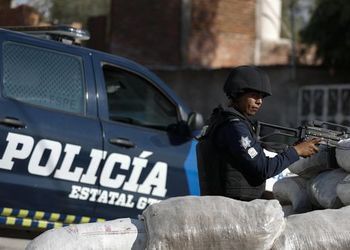Mexico’s Santa Rosa de Lima Cartel has found itself on the ropes, fending off authorities and attacks by the rival Jalisco Cartel and the government.
In recent months, police operations have hit the Santa Rosa de Lima Cartel (CSRL) and its leader, José Antonio Yépez Ortiz, alias “El Marro,” hard. Five members were captured in an April 12 raid, in which authorities also seized high-powered weapons.
A joint marine and police raid in March led to the arrest of the crime boss’s father in the state of Guanajuato, La Opinión reported. Seven cartel operatives were also captured in the operation, Página Central reported, citing statements by Sophia Huett López, the commissioner of the state’s citizen security strategy unit.
In response, cartel gunmen blocked roads with burning vehicles in Celaya, a central city in Guanajuato, Milenio reported. Seven other municipalities in Guanajuato, the cartel’s stronghold, also saw their roads blocked in March.
The latest blows to the CSRL follow the alleged arrest of 35 members in a massive sweep by authorities in January. The group, known for dominating the oil theft racket, has been a target of President Andrés Manuel López Obrador, who promised to stanch the siphoning of fuel from the country’s pipelines.
SEE ALSO: Profile of José Antonio Yépez Ortiz, alias ‘El Marro’
At the same time, the Jalisco New Generation Cartel (Cartel de Jalisco Nueva Generación – CJNG) has ramped up its longstanding war against the Santa Rosa de Lima Cartel in an effort to corner El Marro.
In January, CJNG members burst into the church where El Marro’s sister, Karem Elizabeth Yépez Ortiz, was celebrating her wedding. The gunmen opened fire, killing the bride. El Marro managed to escape the gunfire.
The conflict between the CJNG and CSRL has turned Guanajuato into the most murderous state in Mexico. In 2019, the state recorded nearly 4,500 homicides, according to information from the Executive Secretariat of the National Public Security System.
In March 2019, President López Obrador announced an operation called Golpe de Timón, meaning a “Change of Course,” aimed at dismantling the Santa Rosa de Lima Cartel.
InSight Crime Analysis
Even with its bank accounts frozen and under constant attacks from authorities and its rivals, the Santa Rosa de Lima Cartel has so far managed to stave off its demise.
Víctor Sánchez, a security consultant and expert from the University of Coahuila, told InSight Crime that the group’s resiliency stems from three factors: its leader, its diverse income sources and its roots in the communities where it operates.
According to Sánchez, the CSRL has managed to hold onto its territories in Guanajuato despite confrontations with the CJNG and state forces because El Marro has managed to stay atop the group and lead it.
Additionally, the CSRL retains a core group of members dedicated to extortion who collect a considerable amount of income. The influx of cash keeps them tied to the organization despite its recent economic difficulties.
Likewise, an advantage that the group has over the CJNG is that its cells dedicated to oil theft, are deeply rooted in the communities where they operate, Sánchez added.
SEE ALSO: Mexico’s Santa Rosa de Lima Cartel Risks Burning Too Bright, Too Fast
Jaime López-Aranda, a former Mexican high-ranking police officer now working as a security consultant, told InSight Crime that though the group may rely on protection from local authorities, its influence does not reach state or federal levels which will limit its ability to survive in the long run.
Another issue limiting the group’s expansion is the fragility of its alliances with groups like Los Viagras or the Sinaloa Cartel to confront the CJNG.
Víctor Sánchez said that while these organizations have allegedly loaned supplies and personnel to support the CSRL in its efforts, they have not coordinated actions that would allow the group to gain power.
For these reasons, both experts consulted by InSight Crime agreed that the CSRL is unlikely to survive much longer.

